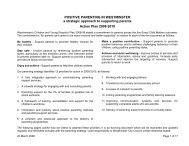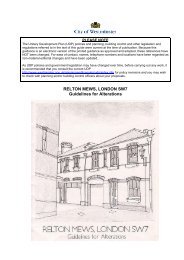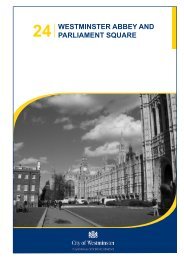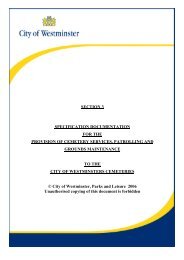Statement of Licensing Policy (2008) WCC - Westminster City Council
Statement of Licensing Policy (2008) WCC - Westminster City Council
Statement of Licensing Policy (2008) WCC - Westminster City Council
Create successful ePaper yourself
Turn your PDF publications into a flip-book with our unique Google optimized e-Paper software.
23. It is widely acknowledged and recognised by the Home Offi ce that there are stronglinks between the consumption <strong>of</strong> alcohol and crime. Nationally, alcohol is a factorin 30% <strong>of</strong> city centre arrests 27 and this proportion is rising. However, the number <strong>of</strong>convictions and cautions for drunkenness are now at only 70% <strong>of</strong> their 1991 levels andthose for the selling <strong>of</strong> alcohol to under 18’s and those for the purchasing <strong>of</strong> alcoholby under 18’s, are at 25% and 10% <strong>of</strong> their 1991 levels. This is more to do with policingresources and priorities as any actual reduction in these <strong>of</strong>fences. 28 Alcohol alsocauses an increase in anti-social behaviour, with some 43% <strong>of</strong> violent incidents beingunder the infl uence <strong>of</strong> alcohol misuse 2924. The analytic study proceeding the Government’s Alcohol Harm Reduction Strategyrecognises that the likelihood <strong>of</strong> aggression and violence is heavily infl uenced byboth the characteristics <strong>of</strong> licensed premises and their surrounding environment. Thefactors on the premises identifi ed affecting incidence <strong>of</strong> violence include• the skill, experience, attitude and management• a young clientele especially if allowed to drink to intoxication• the layout and design <strong>of</strong> premises, if leading to crowding and queuing• unpleasant, poorly ventilated premises• a lack <strong>of</strong> seating• playing loud music25. The factors in the surrounding environment include competition for scarce resourcessuch as transport. This is exacerbated in areas where there is a high density <strong>of</strong>venues, if there is a lack <strong>of</strong> public transport and if venues all close at the same time.3526. Data on the location <strong>of</strong> crime reports for violent crime for the year April 2006- March2007 been analysed. This is the fi rst set <strong>of</strong> data that covers a period when the<strong>Licensing</strong> Act 2003 has been fully in operation. Analysis has been focussed on violentcrime, between midnight and 03:59. This is the period when these types <strong>of</strong> crime aremost <strong>of</strong>ten committed. Midnight is the latest time that pubs can be open under thecore hours and the next four hours is the key time for the operation <strong>of</strong> the night-timeeconomy.27. These analyses show that the overall numbers <strong>of</strong> reports <strong>of</strong> these crimes at later hoursthat can be mapped have been dropping over the past three years, although the rate<strong>of</strong> decrease between midnight and 04:00 is less than the earlier part <strong>of</strong> the night.27 Alcohol Harm Reduction Project Interim Analytical report Simmons et al (2003)28 Alcohol Harm Reduction Project Interim Analytical report Lan Ho et al (2002)29 Crime in England and Wales 2005/6 Home Office Bulletin quoted in Safer Sensible Social: the next steps in the nationalalcohol strategy135
















